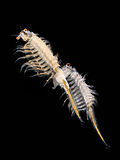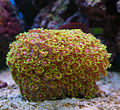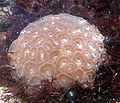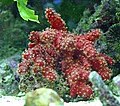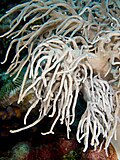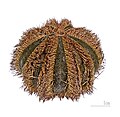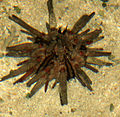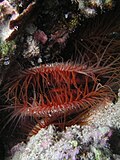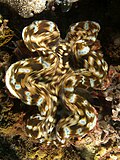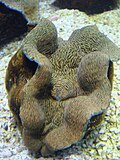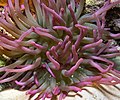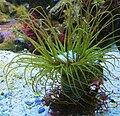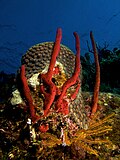
Marine angelfish are perciform fish of the family Pomacanthidae. They are found on shallow reefs in the tropical Atlantic, Indian, and mostly western Pacific Oceans. The family contains seven genera and about 86 species. They should not be confused with the freshwater angelfish, tropical cichlids of the Amazon Basin.

Anthozoa is a class of marine invertebrates which includes the sea anemones, stony corals and soft corals. Adult anthozoans are almost all attached to the seabed, while their larvae can disperse as part of the plankton. The basic unit of the adult is the polyp; this consists of a cylindrical column topped by a disc with a central mouth surrounded by tentacles. Sea anemones are mostly solitary, but the majority of corals are colonial, being formed by the budding of new polyps from an original, founding individual. Colonies are strengthened by calcium carbonate and other materials and take various massive, plate-like, bushy or leafy forms.
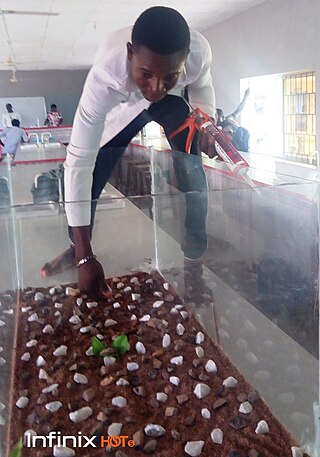
An aquarist is a person who manages aquariums, either professionally or as a hobby. They typically care for aquatic animals, including fish and marine invertebrates. Some may care for aquatic mammals. Aquarists often work at public aquariums. They may also work at nature reserves, zoos, and amusement parks. Some aquarists conduct field research outdoors. In business, aquarists may work at pet stores, as commercial fish breeders, or as manufacturers. Some aquarists are hobbyists, also known as "home aquarists," who may vary in skills and experience.

A reef aquarium or reef tank is a marine aquarium that prominently displays live corals and other marine invertebrates as well as fish that play a role in maintaining the tropical coral reef environment. A reef aquarium requires appropriately intense lighting, turbulent water movement, and more stable water chemistry than fish-only marine aquaria, and careful consideration is given to which reef animals are appropriate and compatible with each other.
Reef safe is a distinction used in the saltwater aquarium hobby to indicate that a fish or invertebrate is safe to add to a reef aquarium. There is no fish that is completely reef safe. Every fish that is commonly listed as reef safe are species that usually do not readily consume small fish or invertebrates. Fish listed as reef safe also do not bother fellow fish unless in some cases, for instance tangs, they do not get along with conspecifics and sometimes fish with similar color or body shape. Every fish has a personality, is different, and, in some cases, are opportunistic feeders. Tangs, which by most accounts are reef safe, may in adulthood eat some crustaceans shortly after they molt. Many larger predatory fish, for instance eels and pufferfish, will adapt very well to a reef tank and will be problem-free as long as they have sizable tank-mates and no crustaceans. Some aquarists have also had success in keeping smaller fish with predatory ones in reef tanks by adding the smaller fish at night, sometimes with newly rearranged rockwork.
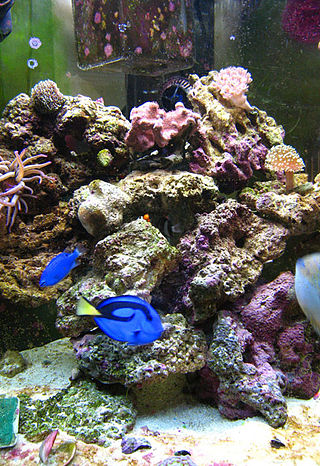
A marine aquarium is an aquarium that keeps marine plants and animals in a contained environment. Marine aquaria are further subdivided by hobbyists into fish only (FO), fish only with live rock (FOWLR), and reef aquaria. Fish only tanks often showcase large or aggressive marine fish species and generally rely on mechanical and chemical filtration. FOWLR and reef tanks use live rock, a material composed of coral skeletons harboring beneficial nitrogen waste metabolizing bacteria, as a means of more natural biological filtration.

Fishkeeping is a popular hobby, practiced by aquarists, concerned with keeping fish in a home aquarium or garden pond. There is also a piscicultural fishkeeping industry, serving as a branch of agriculture.

Zoanthids are an order of cnidarians commonly found in coral reefs, the deep sea and many other marine environments around the world. These animals come in a variety of different colonizing formations and in numerous different colors. They can be found as individual polyps, attached by a fleshy stolon or a mat that can be created from small pieces of sediment, sand and rock. The term "zoanthid" refers to all animals within this order Zoantharia, and should not be confused with "Zoanthus", which is one genus within Zoantharia.
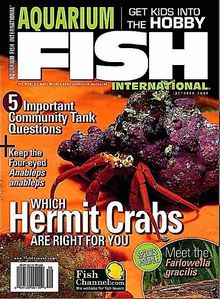
Aquarium Fish International (AFI) was a North American monthly magazine, published by BowTie Inc. of Irvine, California, and dedicated to freshwater and saltwater fishkeeping and the aquarium/fishkeeping hobby in general.

Thor amboinensis, commonly known as the squat shrimp or sexy shrimp, is a species of shrimp found across the Indo-West Pacific and in parts of the Atlantic Ocean. It lives symbiotically on corals, sea anemones and other marine invertebrates in shallow reef communities.

Aiptasia is a genus of a symbiotic cnidarian belonging to the class Anthozoa. Aiptasia is a widely distributed genus of temperate and tropical sea anemones of benthic lifestyle typically found living on mangrove roots and hard substrates. These anemones, as well as many other cnidarian species, often contain symbiotic dinoflagellate unicellular algae of the genus Symbiodinium living inside nutritive cells. The symbionts provide food mainly in the form of lipids and sugars produced from photosynthesis to the host while the hosts provides inorganic nutrients and a constant and protective environment to the algae. Species of Aiptasia are relatively weedy anemones able to withstand a relatively wide range of salinities and other water quality conditions. In the case of A. pallida and A. pulchella, their hardiness coupled with their ability to reproduce very quickly and out-compete other species in culture gives these anemones the status of pest from the perspective of coral reef aquarium hobbyists. These very characteristics make them easy to grow in the laboratory and thus they are extensively used as model organisms for scientific study. In this respect, Aiptasia have contributed a significant amount of knowledge regarding cnidarian biology, especially human understanding of cnidarian-algal symbioses, a biological phenomenon crucial to the survival of corals and coral reef ecosystems. The dependence of coral reefs on the health of the symbiosis is dramatically illustrated by the devastating effects experienced by corals due to the loss of algal symbionts in response to environmental stress, a phenomenon known as coral bleaching.

Stichodactyla gigantea, commonly known as the giant carpet anemone, is a species of sea anemone that lives in the Indo-Pacific area. It can be kept in an aquarium but is a very challenging species to keep alive and healthy for more than 3–5 years.

An aquarium is a vivarium of any size having at least one transparent side in which aquatic plants or animals are kept and displayed. Fishkeepers use aquaria to keep fish, invertebrates, amphibians, aquatic reptiles, such as turtles, and aquatic plants. The term aquarium, coined by English naturalist Philip Henry Gosse, combines the Latin root aqua, meaning 'water', with the suffix -arium, meaning 'a place for relating to'.

Pomacanthus navarchus, the blue-girdled angelfish or majestic angelfish, is a marine angelfish from the Indo-Pacific region. It occasionally makes its way into the aquarium trade. P. navarchus is one of the smallest of the larger species of angelfish. It grows to a maximum length of 28 centimetres (11 in), but is usually much smaller than this, and can live to be up to 21 years old. Younger fish stay closer to the shallows, but the more mature fish can be found up to 120 feet (37 m) deep. Majestic angelfish eat mainly sponges and tunicates. Juvenile fish are mostly blue in color with white stripes. As they mature, they take on a yellow coloration on the flanks, dorsal fin, and tail.

Palythoa is a genus of anthozoans in the order Zoantharia.

Eunicea is a genus of gorgonian-type octocorals in the family Plexauridae. These branched octocorals typically have knobby protuberances from which the polyps protrude. They are often stiffened by purple sclerites and some colonies, in brightly lit back-reef areas are purple, though most colonies are brown or grey. The polyps in some species are large and feathery in appearance. The growth of these corals is rapid and they can be kept in a reef aquarium.
Palythoa toxica, also referred to by its Hawaiian common name, limu-make-o-Hana, is a species of zoanthid native to Hawaii. It is notable as the species in which palytoxin was discovered and from which it was first isolated.
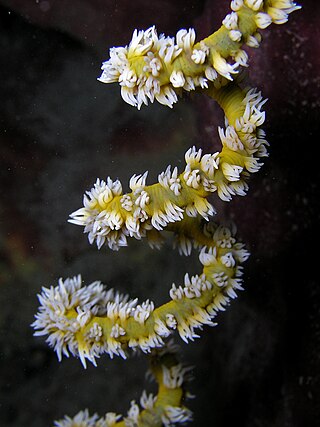
Cirrhipathes is a genus of black coral from the family Antipathidae. Coral species in this genus are commonly known as whip or wire corals because they often exhibit a twisted or coiled morphology. In addition to their colorful appearance, with colors ranging from yellow to red passing through blue and green, these species possess a dark skeleton that is characteristic to every black coral.













